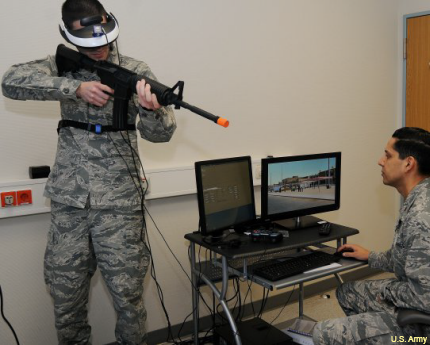How virtual reality helps treat soldiers with PTSD
Immersive, 360-degree simulations are being used in the therapy to help soldiers relive their experiences.

A behavioral health specialist aims his weapon during a demonstration of how Virtual Reality Exposure Therapy can be used to treat Post-Traumatic Stress Disorder.
Part of the treatment for soldier suffering from Post-Traumatic Stress Disorder is getting them to relive their traumatic experience in order to help them process the negative feelings associated with it. To help, the Army has turned to Virtual Reality Exposure Therapy, which uses immersive simulations to help treat PTSD and other conditions, including chronic pain.
For soldiers, this interactive virtual tool allows them to cope with certain stressors they may have experienced in the past, and do it at their own pace. "It's an extremely effective treatment because it is a patient's personalized reality that they learn to process, control and regulate," Dr. Michael Valdovinos, chief of outpatient behavioral health at Landstuhl Regional Medical Center in Germany, said in an Army release. "Visual memory is powerful, and if I can use that to help patients create their own movie scene, then they can move into it to rewrite their own script."
The process of repetition enables patients to decrease symptoms of anxiety and fear, allowing them to move around in recreated virtual environments. Patients learn to process the negative thoughts, feelings and emotions associated with bad events in the past by reworking them in a virtual, non-stressful environment, researchers said.
There are roughly 30 patients who have been treated with VRET since it was donated to LRMC by the Wounded Warrior Project. LMRC, the Army’s largest outpatient behavioral health clinic in Europe, is the only one with this innovated technological therapy.
VRET helps patients deal with events that haven’t been resolved through other forms of treatment, the Army said. In one example, Valdovinos worked with a patient who had lost his best friend during an ambush inside a building. By virtually recreating the building and having the soldier repeatedly enter it, amid virtual fire, the soldier eventually was able to reduce the anxiety he felt entering the building. Valdovinos said this kind of repetition in a virtual environment can help soldiers learn to process negative thoughts associated with the trauma.
There has been a body of research of research that has examined the benefits of using this technological solution as therapy for returning soldiers who might be suffering from PTSD. The Army has been employing it at centers in the United States for some years. Expanding VRET’s use in Europe is further evidence of its effectiveness.



